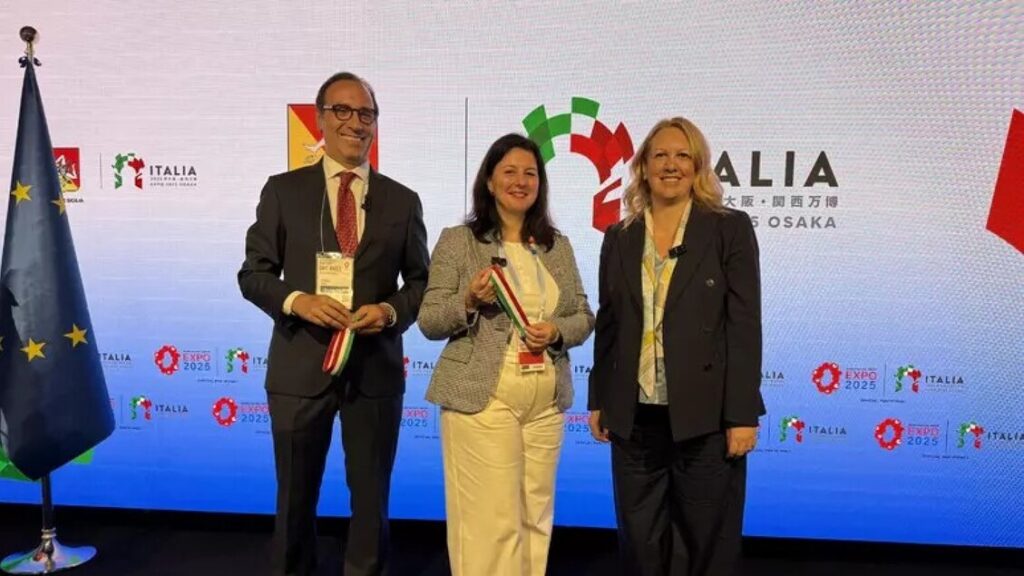Sicily has cut the ribbon of the week
dedicated to the southern Italian region inside the Italy
Pavilion at Expo 2025 Osaka.
Six niches furnished like small sets are dedicated to the main
sectors of traditional Sicilian craftsmanship, ranging from the
skill and mastery of local goldsmithing and silver processing,
to ceramics, cart painting, confectionery, embroidery, weaving
and lava rocks.
A seventh niche showcases the Grains of Peace, an installation
with 1,000 ceramic grains of rice.
It is a “wide-ranging tale of extremely high quality and great
fascination”, said Elena Sgarbi, the Deputy Commissioner for
Italy at Expo 2025 Osaka.
According to Sgarbi, the region sets “the perfect example of
what we want to say through the Italy Pavilion”, or the story of
“a country that was born from a very ancient history of which it
is proud, a history that provides the roots anchoring us and
making us safe but” also “allow us to be projected into a future
where innovation, technology, as well as the maintenance and
preservation of traditions walk hand in hand”.
Indeed, like pioneer aviator Arturo Ferrarin travelled from
Italy to Japan in 1920, “today Sicilians go to Japan to tell a
beautiful story, a story that is not only rich in traditions,
but also full of modernity”, said Alessandro Aricò, the Sicilian
councillor of Infrastructure and Mobility.
The councillor explained that on Wednesday, “June 12, I will be
able to illustrate the whole qualitative leap that is taking
place in Sicily, especially in infrastructures, not only with
the construction of the strait bridge” connecting the island to
mainland Italy but also “progress in naval transport” because
the “first Sicilian-made ship is being built, promoted by this
government and produced in the shipyard of Palermo, which will
connect Sicily to the island of Lampedusa”.
Many themes were brought to the attention of visitors during the
ribbon-cutting ceremony.
The focus was not only on history and culture, explained
Sicily’s Councillor of the Territory and the Environment Giusi
Savarino, because “we wanted to bring something new compared to
all the other Expos in which we participated” by showcasing “for
the first time a story connected to the system of natural areas”
in the region.
The Italy Pavilion is the epitome of sustainability, added
Savarino, stressing that “this attention to the environment is
also shared by the Sicily Region” because “we not only invest in
our natural beauty – we have four regional parks, one national
park, 75 reserves, 245 Siti Natura 2000 (a network of natural
areas) and 93 geological sites – but we are also investing in
boosting the safeguard of natural beauty and we will soon have
our latest pearl which is Punta Bianca (white tip), a new
reserve, and we are working on another reserve in the area of
Siracusa and another in the area of Trapani”, she added.
And the mission doesn’t end here, noted Savarino.
The councillor stated that “we are trying to go beyond the
preservation and safeguard of what nature gave us, we also want
to make it more accessible”.
The Clara Project, named after a character in ‘Heidi’, Johanna
Spyri’s classic story about a Swiss orphan girl who lives with
her lonely old grandfather high up in the Alps, is part of this
vision.
Clara is Heidi’s wheelchair-bound friend who is unable to reach
the highest mountain peaks.
So Heidi’s grandfather finds a way to carry Clara by inventing a
portable chair.
“We bought these backpack-like chairs, which are now more
evolved and safer, and we manage protocols of agreement,
together with the Red Cross, to provide access to reserves and
parks to those who have a disability or motor issues”, concluded
Savarino.
ALL RIGHTS RESERVED © Copyright ANSA


AloJapan.com